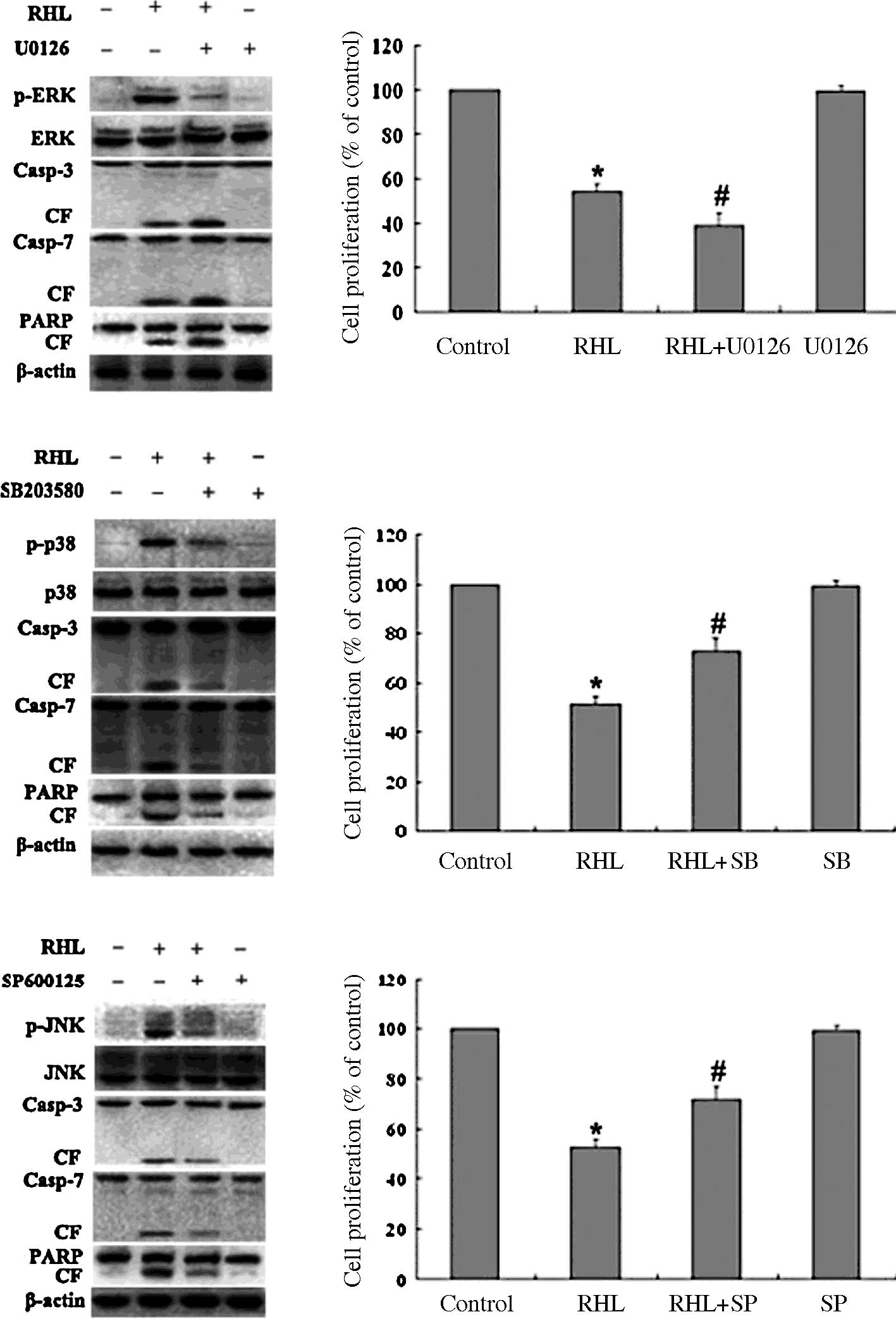|
1
|
Parkin DM, Bray F, Ferlay J and Pisani P:
Global cancer statistics, 2002. CA Cancer J Clin. 55:74–108. 2005.
View Article : Google Scholar
|
|
2
|
Kuo PL, Hsu YL, Ng LT and Lin CC: Rhein
inhibits the growth and induces the apoptosis of Hep G2 cells.
Planta Med. 70:12–16. 2004. View Article : Google Scholar : PubMed/NCBI
|
|
3
|
Huang Q, Lu G, Shen HM, Chung MC and Ong
CN: Anti-cancer properties of anthraquinones from rhubarb. Med Res
Rev. 27:609–630. 2007. View Article : Google Scholar : PubMed/NCBI
|
|
4
|
Lai WW, Yang JS, Lai KC, et al: Rhein
induced apoptosis through the endoplasmic reticulum stress,
caspase-and mitochondria-dependent pathways in SCC-4 human tongue
squamous cancer cells. In Vivo. 23:309–316. 2009.
|
|
5
|
Ip SW, Weng YS, Lin SY, et al: The role of
Ca2+ on rhein-induced apoptosis in human cervical cancer
Ca Ski cells. Anticancer Res. 27:379–389. 2007.
|
|
6
|
Lin ML, Chen SS, Lu YC, et al: Rhein
induces apoptosis through induction of endoplasmic reticulum stress
and Ca2+-dependent mitochondrial death pathway in human
nasopharyngeal carcinoma cells. Anticancer Res. 27:3313–3322.
2007.PubMed/NCBI
|
|
7
|
Cichewicz RH, Zhang Y, Seeram NP and Nair
MG: Inhibition of human tumor cell proliferation by novel
anthraquinones from daylilies. Life Sci. 74:1791–1799. 2004.
View Article : Google Scholar : PubMed/NCBI
|
|
8
|
Floridi A, Gentile PF, Bruno T, et al:
Cytotoxic effect of the association of BCNU with rhein or
lonidamine on a human glioma cell line. Anticancer Res. 11:789–792.
1991.PubMed/NCBI
|
|
9
|
Lin YJ and Zhen YS: Rhein lysinate
suppresses the growth of breast cancer cells and potentiates the
inhibitory effect of Taxol in athymic mice. Anticancer Drugs.
20:65–72. 2009. View Article : Google Scholar : PubMed/NCBI
|
|
10
|
Lin YJ, Zhen YZ, Shang BY and Zhen YS:
Rhein lysinate suppresses the growth of tumor cells and increases
the anti-tumor activity of Taxol in mice. Am J Chin Med.
37:923–931. 2009. View Article : Google Scholar : PubMed/NCBI
|
|
11
|
Lin YJ, Huang YH, Zhen YZ, Liu XJ and Zhen
YS: Rhein lysinate induces apoptosis in breast cancer SK-Br-3 cells
by inhibiting HER-2 signal pathway. Yao Xue Xue Bao. 43:1099–1105.
2008.PubMed/NCBI
|
|
12
|
Schaeffer HJ and Weber MJ:
Mitogen-activated protein kinases: specific messages from
ubiquitous messengers. Mol Cell Biol. 19:2435–2444. 1999.PubMed/NCBI
|
|
13
|
Wen J, Cheng HY, Feng Y, et al: p38 MAPK
inhibition enhancing ATO-induced cytotoxicity against multiple
myeloma cells. Br J Haematol. 140:169–180. 2008. View Article : Google Scholar : PubMed/NCBI
|
|
14
|
Shtil AA, Mandlekar S, Yu R, et al:
Differential regulation of mitogen-activated protein kinases by
microtubule-binding agents in human breast cancer cells. Oncogene.
18:377–384. 1999. View Article : Google Scholar : PubMed/NCBI
|
|
15
|
Kyriakis JM and Avruch J: Mammalian
mitogen-activated protein kinase signal transduction pathways
activated by stress and inflammation. Physiol Rev. 81:807–869.
2001.PubMed/NCBI
|
|
16
|
Wang TH, Wang HS, Ichijo H, et al:
Microtubule-interfering agents activate c-Jun N-terminal
kinase/stress-activated protein kinase through both Ras and
apoptosis signal-regulating kinase pathway. J Biol Chem.
273:4928–4936. 1998. View Article : Google Scholar
|
|
17
|
Stone AA and Chambers TC: Microtubule
inhibitors elicit differential effects on MAP kinase (JNK, ERK, and
p38) signaling pathways in human KB-3 carcinoma cells. Exp Cell
Res. 254:110–119. 2000. View Article : Google Scholar : PubMed/NCBI
|
|
18
|
Zhen YZ, Lin YJ, Li Y and Zhen YS:
Lidamycin shows highly potent cytotoxic to myeloma cells and
inhibits tumor growth in mice. Acta Pharmacol Sin. 30:1025–1032.
2009. View Article : Google Scholar : PubMed/NCBI
|
|
19
|
Zhen YZ, Lin YJ, Shang BY and Zhen YS:
Enediyne lidamycin induces apoptosis in human multiple myeloma
cells through activation of p38 mitogen-activated protein kinase
and c-Jun NH2-terminal kinase. Int J Hematol. 90:44–51. 2009.
View Article : Google Scholar : PubMed/NCBI
|
|
20
|
Hideshima T, Catley L, Yasui H, et al:
Perifosine, an oral bioactive novel alkylphospholipid, inhibits Akt
and induces in vitro and in vivo cytotoxicity in human multiple
myeloma cells. Blood. 107:4053–4062. 2006. View Article : Google Scholar : PubMed/NCBI
|
|
21
|
Park WH, Seol JG, Kim ES, et al: Induction
of apoptosis by vitamin D3 analogue EB1089 in NCI-H929 myeloma
cells via activation of caspase 3 and p38 MAP kinase. Br J
Haematol. 109:576–583. 2000. View Article : Google Scholar : PubMed/NCBI
|
|
22
|
Shimizu T, Nakazato T, Xian MJ, Sagawa M,
Ikeda Y and Kizaki M: Resveratrol induces apoptosis of human
malignant B cells by activation of caspase-3 and p38 MAP kinase
pathways. Biochem Pharmacol. 71:742–750. 2006. View Article : Google Scholar : PubMed/NCBI
|
|
23
|
Pei XY, Dai Y, Tenorio S, et al: MEK1/2
inhibitors potentiate UCN-01 lethality in human multiple myeloma
cells through a Bim-dependent mechanism. Blood. 110:2092–2101.
2007. View Article : Google Scholar : PubMed/NCBI
|
|
24
|
Lunghi P, Giuliani N, Mazzera L, et al:
Targeting MEK/MAPK signal transduction module potentiates
ATO-induced apoptosis in multiple myeloma cells through multiple
signaling pathways. Blood. 112:2450–2462. 2008. View Article : Google Scholar
|
|
25
|
Ozaki K, Kosugi M, Baba N, et al: Blockade
of the ERK or PI3K-Akt signaling pathway enhances the cytotoxicity
of histone deacetylase inhibitors in tumor cells resistant to
gefitinib or imatinib. Biochem Biophys Res Commun. 391:1610–1615.
2010. View Article : Google Scholar : PubMed/NCBI
|













